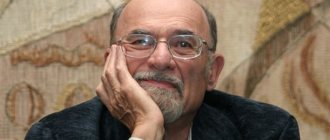“Life has no meaning”, “I am hopelessly alone and will never find understanding”, “My loved ones will die one day, and this is terrible!” Such thoughts periodically visit people's heads, causing feelings of anxiety, sadness and hopelessness. Existential psychology helps to overcome such a thinking model. Her goal is to resolve personal internal conflict and restore the joy of life.
You will learn more details by taking a few minutes to read this article, but before that, a little knowledge check on the topic.
And now, in fact, let's move on to the article itself.
Definition and main ideas of existential psychology
Existential psychology is based on a philosophical approach and is the process of finding value and meaning in life. It is based on the idea that a person is not a victim of circumstances, but is responsible for his own actions and choices, thereby shaping reality.
Existential psychology takes a positive approach that celebrates human aspirations and abilities while recognizing human limitations. This branch of psychology helps people come to terms with the basic principles of human existence, the so-called givens. There are 4 main existential givens:
- Freedom and the responsibility associated with it. Everyone has freedom of choice. Every decision has consequences, no matter how big or small. To grow, a person must take responsibility, i.e. become the author of your own choices, actions and life. However, many people strive for freedom while trying to avoid responsibility.
- Death. Death is one of the absolute truths of life. Everyone will die at one time or another.
- Loneliness. On the one hand, a person is a social being who desires constant contact with others, on the other hand, he is absolutely alone, because he cannot count on 100% understanding and acceptance of his individual experience by other people.
- Pointlessness. There is no meaning to life. This means that there is no predetermined value. The meaning of life is different for everyone, and each person must find that meaning through their own choices and actions.
The struggle with any of these givens causes intrapersonal conflict and fills a person with fear or existential anxiety. For example, for most people the fact of their own death or the death of relatives is a source of deep anxiety; they persistently ignore reality and refuse to accept the fact that death will occur. There are also those who, to the point of neurosis or psychosis, are fixated on the inevitability of death.
Existential psychology offers a solution: to accept the inevitability of death, being free from its pressure. People who maintain a healthy balance are motivated to make decisions that positively impact their ongoing lives. The reality of death encourages us to make the most of opportunities and appreciate what we already have.
Living an authentic (genuine) life, realizing one’s unique properties and potential is the main call of existential psychology. This can only be achieved by taking responsibility for your own actions and idleness, realizing that inaction is also a decision.
Existential psychology reminds us of the limited time, stimulates us to look for the meaning of life and act in such a way that fate is in the hands of a person. She accepts the inevitability of “normal” anxiety, considering it part of growing up and an adequate reaction to what is happening.
Awakening a sense of responsibility for your decisions
When this problem arises, it will be effective to identify ways of refusing responsibility (using confrontation interviews, paradoxical statements, etc.). Therapy aimed at awakening responsibility, like all existential therapy, excludes the directive style - because in this case there is a great danger of transferring responsibility to the therapist - another trick of the client. Therapy methods should be aimed at strengthening volitional qualities (or awakening them); it is important to take into account personal potential, build goals and desires in order to then translate them into reality, thinking about how this can be done. If there are “no” desires, there is work to be done to find oneself, to feel the client’s taste for life.
The main representatives of existential psychology and the chronology of its development
The ancestor of existential psychology was the philosophy of existence or existentialism. Let us consider how the views of philosophers and psychologists on human existence developed.
Søren Kierkegaard
Danish philosopher Søren Kierkegaard was the founder of existentialism. He identified three stages of human existence: aesthetic, ethical and religious. The aesthetic stage is a state of “here and now”, it is focused on the experience of pleasure and pain. Small children live in this regime.
The ethical stage involves familiarity with the concepts of choice and responsibility. A person must choose: to live based on personal values, or to obey the rules accepted in society. Kierkegaard believed that submission, although it leads to a simplification of life, is a dead end for the individual.
This contradiction can be overcome by living in a religious manner. However, difficulties arise here too: on the one hand, a person realizes his uniqueness, on the other, his complete failure in comparison with God. The result is negative feelings: loneliness, anxiety and fear, which, as Kierkegaard believed, allow us to see the truth and lead to authentic existence.
Friedrich Nietzsche
Another philosopher who contributed to the development of existentialism was the enigmatic German Friedrich Nietzsche. He believed that the fundamental force of this world is the will to power. According to Nietzsche, life is extremely difficult and the universe is rigged against humanity: natural forces such as natural disasters and disease destroy people physically, inequality is the natural state of society, God is dead, and there is no afterlife.
The philosopher saw a great future for the superman. With this term, he characterized a person who was able to realize his full potential, mastered himself and abandoned the “herd morality” in order to create his own values and live in accordance with them.
Martin Heidegger
The German existentialist Martin Heidegger also explored the role of man in the world and trivialized the nature of God, considering him to be a being of a slightly higher order than man.
Heidegger argued that people's natural ability is to be aware of their connection to truth. The desire to comprehend the truth gives rise to insurmountable anxiety, since a person knows that his life time is limited. Heidegger considered death to be a positive event because it is the awareness of mortality that pushes people to be true to themselves and live an authentic life.
Jean-Paul Sartre
The French writer Jean-Paul Sartre was the man who brought existential philosophy into psychology. He stated that there is no God, and the main goal of human existence is awareness of one’s true essence, discovery of oneself.
Sartre wrote that many people deny their unique ability to create and suppress their enthusiasm, allowing life to flow limply. This leads to anxiety and despair, the person begins to literally feel sick of life. Such conditions necessitate existential psychoanalysis, which, according to Sartre, reveals the true purpose of human existence.
Sartre was sure that no external force has power over people, only we ourselves, thanks to awareness, create reality. He also argued that people are doomed to despair and failure, since their responsibility is absolute, and they cannot count on the support of the Higher Powers.
Victor Frankl
Austrian psychiatrist Viktor Frankl was the developer of logotherapy, a branch of psychotherapy that focuses on finding the meaning of existence.
Frank drew on Kierkegaard's philosophy to argue that the primary driving force in life is the search for meaning, not the desire for sex and pleasure, as the father of psychoanalysis theorized Sigmund Freud, or power, as Nietzsche argued. Logotherapy is a form of existential therapy that emphasizes that people are capable of finding meaning in everything they do: creativity, work, interactions with other people, and even suffering.
Having survived the experience of imprisonment in fascist concentration camps, Frankl wrote that in inhuman conditions life does not lose meaning, and the means of survival becomes an appeal to the spiritual “I”, which cannot be destroyed by external forces.
Rollo May
American psychologist Rollo May was the main popularizer of existential psychology. May argued that human development goes through certain stages, each of which corresponds to a specific type of existential crisis:
- Innocence: The baby has no motives other than the desire to live.
- Rebellion: The child wants freedom, but cannot properly care for himself.
- Decision: the young man makes independent decisions, striving for independence from his parents.
- Ordinariness: an adult, overwhelmed by the demands of life, seeks protection in conformity and following social norms.
- Creativity: productive, creative self-realization, during which a person overcomes selfishness.
According to May, some people skip certain stages and, regardless of age, may return to them repeatedly.
Irwin Yalom
Irvin Yalom is a modern psychiatrist and teacher, the author of a large number of books on existential psychology. It was he who summarized the 4 “ultimate problems of life”: death, freedom, loneliness and meaninglessness, revealed the meaning of each and described the type of conflict that arises as a result of resistance to these existential givens.
In her practice, Yalom teaches people to exist as part of something larger than themselves, recognizing, accepting and not avoiding the fact that there is a place in life for pain, death and sadness.
Dealing with Loneliness
Paradoxically, to cope with loneliness, you need to go deeper into it. As psychologists say, you cannot stop being lonely without the possibility of solitude.
In his work, the therapist will definitely focus on the client’s idea of a partnership that excludes manifestations of dependence and manipulation (if this idea is very approximate, they work on it). As a rule, the client often has a distorted image of a partnership or being in a couple; pathologies often manifest themselves in the form of an aggressive desire to possess a partner, to tell him what to do correctly, to manipulate, or, conversely, the mechanism of “sacrifice”, codependency, etc. is activated.
An important role in the work is played by the “here and now” attitude - in relationships with the therapist, the reasons for loneliness or difficulties in interpersonal interaction always appear. It will be a valuable experience for the client to receive “feedback” from the therapist.
Existential psychology today
Existential therapy is gradually gaining recognition. Relevant specialists practice in 48 countries around the world, and every year the number of people with existential disorders is only growing.
In Man's Search for Meaning, Viktor Frankl called this process an existential vacuum. He believed that the conveniences of the Industrial Revolution had given people a harmful excess of free time, making their lives aimless, boring and sad. It is the existential vacuum, according to Frankl, that underlies depression, aggression and various kinds of addictions.
Modern existential psychotherapists explain the occurrence of the psychological problems listed above by the limited ability to make meaningful and independent decisions about how to live. In this case, the existential approach is aimed at increasing self-awareness and self-understanding.
Therapists help a person find meaning in life by overcoming anxiety, teach them to think and act responsibly, direct attention inward, and work with negative attitudes rather than fight external forces such as social pressure and disapproval. Promoting creativity, love, authenticity and free will are the principles through which existential psychotherapists help people move towards transformation.
Existential psychology is often perceived as morbid, pessimistic, impractical and mystical. It's a delusion. The approach she takes is extremely practical, specific and flexible. It can be formulated as follows: come to terms with reality without denying, avoiding or sugar-coating it, and remember that your choices determine your destiny.
Friends, don’t stop moving, act and look for meaning! On this path, we wish you courage, perseverance and awareness.
We also recommend reading:
- Storytelling
- Psychology of fear
- Narrative therapy
- Psychology of Advertising
- Logotherapy by Viktor Frankl
- Positive psychology
- Genetic psychology
- Hedonism as a way to improve life
- The Foundation for Creating a Mindful Life
- One, two, three, four, five - it’s time to die, or the Kübler-Ross model of grief
- Dan Baker's Happiness Model
Key words: 1Cognitive science, 1Self-knowledge
Therapy for fear of death
This basic fear is inherent in any biological creature - at least at the level of instincts. In existential therapy, it all begins with his recognition and acceptance of the inevitability of the fact of his death.
In this sense, it is effective to draw a line of life and determine your current segment at the moment, a detailed representation of your death with the creation of an obituary or inscription on the grave (sometimes these inscriptions can be made deliberately paradoxical).
Group therapy consisting of healthy and sick people or in groups of a homogeneous type (for example, cancer patients, as described by I. Yalom) has its effect.
An important conclusion from the research of I. Yalom, who interviewed dozens of people doomed to death, was the understanding that those who actively, variedly, and lived their lives to the fullest are less afraid of death. People who have allowed themselves little, who have denied themselves the fulfillment of their big and small desires, are more afraid of death - in fact, the fear of death means regret about an unlived life. Therefore, an important point in therapy will be the awareness of what right now gives a person the strength to live, causes him sincere joy - and building his life so that there is always a place for this.
A technique associated with reducing susceptibility to death (desensitization) has proven itself well - frequent speaking, imagining, rehearsing one’s own death.
History, representatives
Humanistic psychology - brief and clear
Attention! Researchers cannot say for sure who was the founder of the new direction in the study of personality in psychology. Existentialism in psychology is associated with the ideas of B. Medard, L. Binswanger, R. May, A. Lenglet, K. Jaspers. In Russia, representatives of existential psychologists are F.I. Dostoevsky and L.N. Tolstoy.
Throughout the 19th century, existential psychology actively developed, and narrowly focused branches were formed, one of which is logotherapy. This is a type of psychotherapy, the founder of which is considered to be V. Frankl. As an existential psychologist, V. Frankl distinguished himself by the fact that he tested all the psychotherapeutic methods and techniques of this direction on himself. Classes with him helped clients find a way out of difficult life situations and find meaning in life.
Loss of meaning in life
Such problems often arise in adolescence - or later, at turning points. Here it is important to stimulate the client’s self-expression, to shift the angle of perception from a focus on internal processes to the outside in order to gain meaning (sometimes a narrowed perception drives a person into a dead end). This is facilitated by visits to orphanages, hospices, volunteer work, and any appeal to someone else’s, even more dramatic, experience. Often a person who feels abandoned and lonely, useless to anyone, brightens simply from the eyes with which his children, deprived of parental care, greet and see him off, and realizes his own importance, relevance, and need on a non-verbal level.
It will also be important in the therapy process to think together about different aspects of events, taking into account V. Frankl’s principle: all events are neutral, and only a person colors them in light or dark tones. Flexibility of thinking is an important quality both in therapy and during the patient’s subsequent self-help. If we take as a postulate the belief that there is no only bad or unambiguously good in life, this in itself will have an important therapeutic effect.
And it is quite possible that the most important thing in existential therapy is what Irvin Yalom spoke about - the manifestation of participation in the client, involvement in his life and the meanings with which it is filled. Attitude therapy is a powerful weapon in the hands of a psychologist. Who knows, maybe this is the client’s last opportunity to be unconditionally accepted and heard.
SYMBOLDRAMA
A method that, with the help of certain images specified by the psychotherapist, helps to “pull out” from our unconscious those conflicts and problems that caused the condition that requires correction. The session itself usually includes several stages: a preliminary conversation with a psychotherapist, a relaxation procedure, then directly working with the image under the supervision of a doctor and a final conversation.
ADVANTAGES OF THE METHOD Combines well with other methods. Suitable for use with children. In addition, relaxation and pleasant images have an overall beneficial effect on a person’s emotional state.
WHO IS IT SUITABLE FOR?
Great for phobias (fears of the dark, heights, closed spaces and others). It works well for nervous tension, chronic fatigue syndrome, and insomnia. Used for depression, stress and other anxiety disorders. Helps increase self-esteem and cope with persistent failures.
BODY-ORIENTED PSYCHOTHERAPY
In this method, it is believed that our unprocessed emotions and suppressed experiences remain imprints in our body in the form of muscle clamps.
Simply put, our body “records” everything that happens to us. When we experience depressive moods or other anxious states, we, without realizing it, spend a huge part of ourselves and our energy (using muscle tension, among other things) to maintain defense mechanisms that protect us from real or imagined dangers. The goal of therapy is through special exercises and massage:
1) relieve muscle tension and, so to speak, “split” the clamps;
2) understand and feel your body in a new way, feel how it reacts emotionally to the outside world and to your own thoughts.
ADVANTAGES OF THE METHOD With this method, it is NOT necessary to voice out loud an unpleasant traumatic experience. The session itself with a specialist is similar to working within the framework of a massage. The emotional uplift is felt immediately, because... the body is affected.
FEATURE OF THE METHOD
In its pure form it cannot completely relieve the disorder, therefore, in cases of moderate and severe severity (depression), as well as to achieve long-term results, it is used in combination with other methods.
WHO IS IT SUITABLE FOR?
It is used for stress and conflict, for emotional burnout and chronic fatigue, for the treatment of postpartum depression, for correction of weight and eating behavior, and for psychosomatic diseases. It is also often used as part of complex therapy; it helps with various types of neuroses (hysterical, hypochondriacal, somatized neurosis, neurasthenia, obsessive-compulsive neurosis).
FAMILY PSYCHOTHERAPY
Family therapy is a branch of psychotherapy that specializes in problems in family relationships. All work is based on the premise that the problem is within the family as a whole, and not with an individual within the family. This means that you should not expect your therapist to resolve your conflict with the phrase “you are right and you are wrong.” During the conversation, the therapist clarifies the causes of the conflict or problem, helps answer questions and find ways to change the functioning of the system as a whole.
Session format: conversation, various exercises, homework.
ADVANTAGES OF THE METHOD The essence of the work of family psychotherapy is working with a whole system of relationships, situations and individuals, and not with the problem and request of one specific person, as happens in the case of personal sessions. This is what helps achieve results.
FEATURE OF THE METHOD
Get ready to work and dive. No one but yourself will save your family without your desire.
WHO IS IT SUITABLE FOR? Treason. This situation is difficult for both partners to bear. And even in the case when the spouses decide to “forgive and forget,” the residue and consequences still remain in the family. Constant protracted conflicts. You are close to divorce, but the final decision has not yet been made. Sexual disharmony in a couple.
What did religion “bind”
The death of God is, of course, not about a bearded old man in heaven or about atheism. We are talking here about morality, and in a broader sense, about religion. According to one version, the word “religion” comes from the Latin religare - “to bind”: the presence of religion makes the world connected, and not a set of random events. Erich Fromm, a philosopher, neo-Freudian, post-Marxist, suggested using the phrase “system of orientation and worship” instead of the word “religion.” In simpler terms, this can be called a “value system.” If you strip away the obvious superficial idea that morality is Big Daddy scolding, the “orientation and worship system” not only tells you where to bow, but also creates meaning.
Meaning is a derivative of values. A person prefers to do one thing and not do another because for him one is more valuable than the other. Without a guidance system, the world becomes completely frightening and unpredictable: it is unclear where to go (and what you will be punished for).
This can be expressed in different words (for example, “right” or “wrong”, “good” and “evil”), but the essence remains the same: a person moves towards things that are preferable to him. That's the point.
The definition of “system of orientation and worship” ties into one not only religion, but also similar systems that perform the same functions. For example, one of the excellent substitutes for religion is ideology, a relatively new invention from the time of Karl Marx, which has flourished only since the 20th century. They didn’t even really disguise themselves: some took the solar symbol (swastika), others took Egyptian ziggurats, mummification, the cult of the dead and post-mortem in the memory of descendants (“Lenin is forever alive in our hearts”).
Methods, techniques, techniques
It is impossible to clearly name the methods of existential psychotherapy, since for each new client the specialist “invents” a special approach to treatment. Therefore, in her arsenal there is a wide selection of techniques and techniques with the help of which a person is brought to light from the dark depths of his own consciousness. As a rule, they are borrowed from other areas:
- manifestation of creative potential through art therapy techniques (depending on the client’s abilities);
- transference and countertransference from Gestalt therapy (work in a team of a client and an existential psychotherapist);
- journaling, distancing, empirical experiments, reappraisal, decentering, decatastrophizing, targeted repetition, procrastination - methods of cognitive therapy;
- role-playing training aimed at acting out and understanding a problem situation from within - from behavioral psychotherapy;
- question-and-answer technique, conversation, pronunciation - the basis of a positive direction;
- bioenergetic psychoanalysis, biodynamics, insight therapy are borrowed from body-oriented psychotherapy.
This is not the entire list of methods and techniques. Despite the fact that 90% of the tools are borrowed from other directions, the arsenal also has its own techniques that allow you to work with the basic concepts of existentialism.
Techniques for working with death awareness:
- “permission to endure” - open discussion of topics about death;
- defense mechanisms - correction of naive views on death;
- dream analysis;
- constant but correct reminders of the fragility of existence;
- deepening awareness of the inevitability of death through auxiliary techniques (writing your own obituary, detailed presentation of your funeral);
- decreased sensitivity to the fear of death, which is given in doses at sessions;
- semantic revaluation of death, search for positive aspects in it.
Techniques for working with personal freedom of choice and responsibility for it:
- admitting one's own guilt;
- awareness of shirking responsibility;
- overcoming boundaries and prohibitions;
- working with conscience, feelings of guilt for making the wrong choice;
- releasing one's own desires;
- decision-making facilitation: every action is preceded by a choice.
Techniques for working with insulation:
- an independently made decision to completely isolate yourself from communication for a while;
- overcoming the contradiction between the need for communication and existential isolation;
- learning the “language of intimacy” - developing automatic skills for expressing feelings;
- establishing a trusting relationship between client and psychotherapist.
Techniques for working with the lack of meaning of being:
- redefining the problem of meaninglessness;
- overcoming anxiety;
- involvement in life;
- establishing and maintaining authentic relationships.
Depending on the identified problem, the psychotherapist may choose a specific block of techniques, or may sequentially include individual moments from them in sessions.
Criticism
Every coin has two sides, and the existential-humanistic direction in psychotherapy is often criticized. The most vulnerable are 4 moments.
The first is many directions and branches. Sometimes they deviate too far from the basic principles of true existential psychotherapy, merge with others, and create separate movements and schools.
The second is the lack of a clear treatment strategy. Each time, based on the situation, it changes, adapting to the client.
Third, counseling for each new client should not be based on previous experience. An existential psychotherapist has no right to draw analogies with other cases from practice.
And the last thing for which critics especially often castigate existential psychotherapy is the lack of humanism, no matter how paradoxical it may sound. The client must be willing to rethink the essence of his being through the key moments of pain that he has experienced. In practice, it turns out that not everyone is able to do this. Sometimes it ends with an exacerbation of psychotrauma.
Origin of name. The term comes from the Latin word "existentia", which translates as "existence". It reflects the essence of the direction in both philosophy and psychotherapy. To know the meaning of one’s existence is the goal of every person, which will help get rid of any problems.
HYPNOTHERAPY
A psychotherapeutic technique that uses a hypnotic state for therapeutic purposes. In a hypnotic state, the patient is completely relaxed, but at the same time consciousness remains present and the person is concentrated on a specific problem or situation.
Important! This technique has nothing in common with various well-known staged shows about hypnosis!
ADVANTAGES OF THE TECHNIQUE
Positive improvements are felt after the first sessions.
FEATURE OF THE METHOD
Contraindicated for pregnant women, people suffering from epilepsy, people with psychiatric diagnoses (schizophrenia, etc.), when taking psychotropic drugs, as well as people under the influence of alcohol.
WHO IS IT SUITABLE FOR?
Effective for phobias, various types of addictions (addiction to alcohol, cigarettes), eating disorders (anorexia, bulimia), post-traumatic syndromes, psychosomatics (migraines, allergies, etc.), insomnia, sexual disorders. It is also recommended for general loss of strength, depression, and stressful conditions as part of complex therapy.











